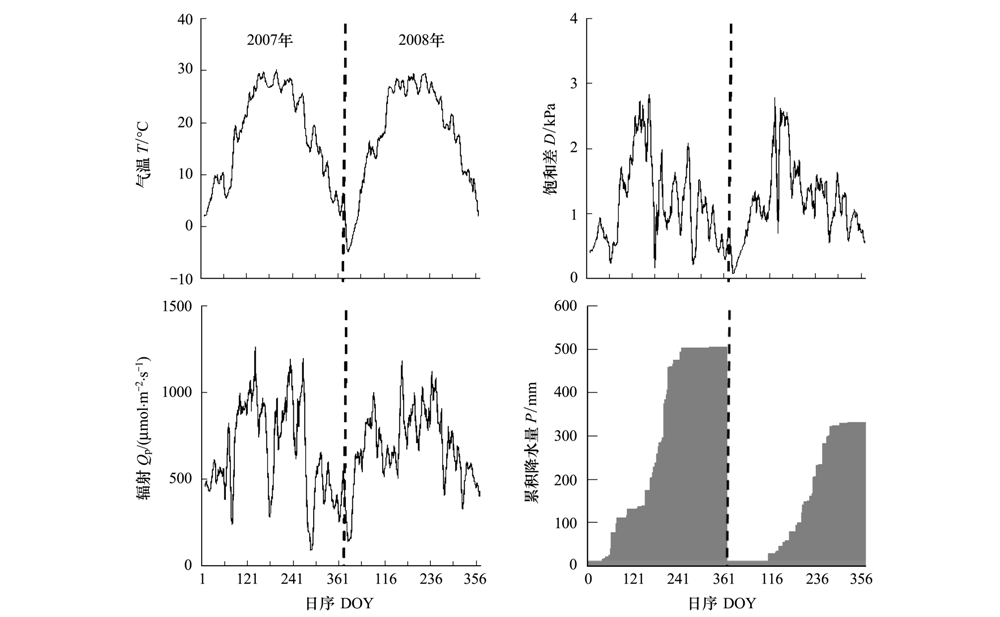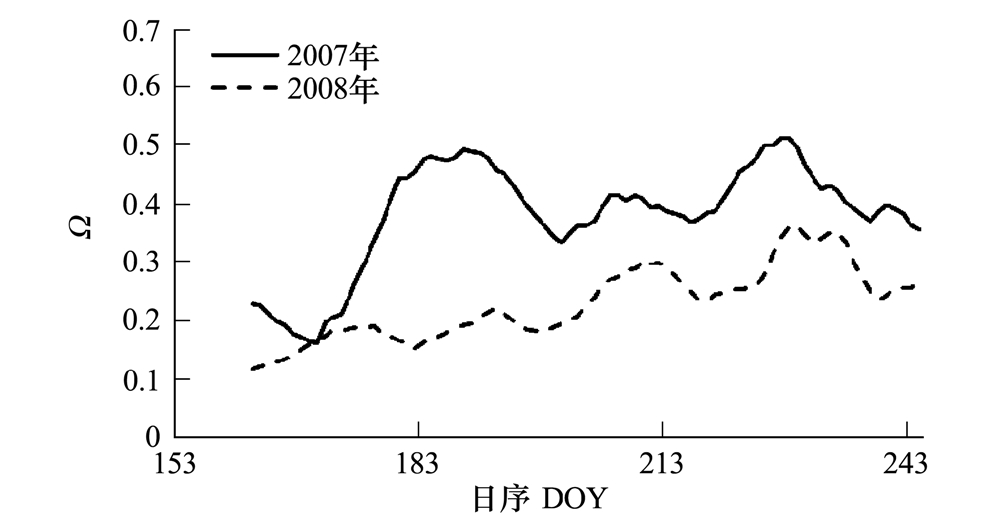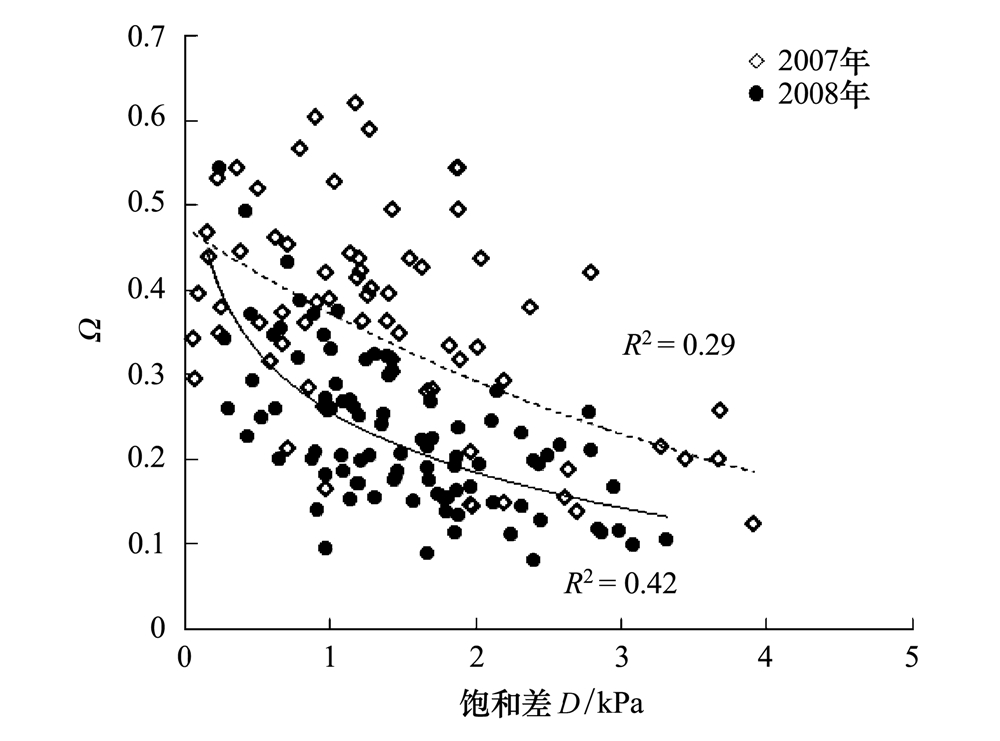文章信息
- 黄辉, 孟平, 张劲松, 郑宁, 贾长荣
- HUANG Hui, MENG Ping, ZHANG Jinsong, ZHENG Ning, JIA Changrong
- 华北低丘山地人工林蒸散的控制因子
- Stomatal and environmental control on evapotranspiration in a plantation in the lower mountain areas of North China
- 生态学报, 2014, 34(3): 667-673
- Acta Ecologica Sinica, 2014, 34(3): 667-673
- http://dx.doi.org/10.5846/stxb201306091509
-
文章历史
- 收稿日期:2013-6-9
- 修订日期:2013-10-10
2. 河南省济源市国有大沟河林场, 济源 454650
2. Dagouhe Forest Farm of Jiyuan, He'nan 454650, China
蒸散(ET)是表征陆地生态系统水分状况的重要指标,了解其控制机制有助于认识生态系统与气候的相互作用关系,以及预测气候变化对生态系统生产力的影响[1]。植被蒸散由土壤蒸发和植被蒸腾组成,环境因子[2, 3, 4, 5]、植被类型及空间配置方式[6, 7]均对蒸腾产生影响。在叶片尺度上,蒸腾作用受气孔运动制约,而气孔运动又对外界环境条件非常敏感[8, 9]。Jarvis和McNaughton[10]提出了一个量化植被冠层气孔行为对群落蒸腾速率控制程度的退耦系数Ω(0 ≤ Ω ≤ 1),当Ω趋于0,植被冠层气孔对群落蒸腾的控制程度非常高,反之,当Ω趋于1,则群落蒸腾更多地依赖于外界气象环境因素的控制。在不同纬度地区、不同植被类型的Ω值表现出很大的变异性,温带阔叶林的Ω值为0.20—0.28[11, 12, 13],而热带低地森林的Ω值可达0.82—0.90[14]。
植被冠层的蒸腾量可通过模型[15]、树干液流[16, 17]和稳定同位素技术[18]等方法估算和测定,然而这些估算方法复杂,且存在许多不确定性。涡度相关技术可长期连续地对植被和大气间物质和能量交换实施监测[19, 20],已被广泛应用于森林蒸散的研究[21],在植被生长旺盛的季节,土壤蒸发仅占蒸散很小的比重,涡度相关方法测定的水汽通量可以近似地作为冠层蒸腾速率。
我国人工林保存面积为0.62亿hm2,居世界首位[22],其在区域水分循环及平衡中发挥的作用不容忽视。黄河小浪底森林生态系统定位研究站位于暖温带季风气候区,是我国林业工程的重点区域。站区春旱频发,夏季高温期如遇降水不足也易发伏旱,实验区内人工林为我国华北丘陵山区造林典型树种,在该地区开展人工林蒸散的影响机制研究对我国林业生态工程建设有重要意义。本文利用涡度相关技术对该站30年生栓皮栎-刺槐-侧柏人工混交林进行了连续2a的观测,选取每年植被生长旺盛季节(6—8月)的水汽通量数据,分析人工林蒸散和退耦系数的季节和年际变化趋势,探讨人工林蒸散的控制因子。
1 材料与方法 1.1 实验区概况及观测方法本文实验点位于国家林业局黄河小浪底森林生态系统定位研究站(35°01′N、112°28′E,410 m;以下简称小浪底站)。定位站位于河南省济源市,地处黄河中游,属暖温带亚湿润季风气候,生长季(4—9月)盛行风向为偏东风,年平均气温为12.4—14.3℃,全年平均日照时数为2367.7 h,多年平均降水量为641.7 mm。受季风气候的影响,降水季节性分配不均,6—9月平均降水量为438.0 mm,占全年的68.3%。研究区主要树种为栓皮栎(Quercus variabilis)、侧柏(Platycladus orientalis)、刺槐(Robinia pseudoacacia)等,平均冠层高度约为11 m。土壤为棕壤和石灰岩风化母质淋溶性褐土。
通量观测塔位于站区中心偏西方向的栓皮栎、侧柏、刺槐团状混交样地内等。塔高36.0 m,塔周围1.8 hm2范围平均坡度约为12°,林木覆盖率约为96.0%,栓皮栎、侧柏、刺槐所占比例分别约为80%、8%和12%。观测塔上装有涡度相关系统及微气象梯度观测系统,仪器的安装情况详见文献[23]。
1.2 数据处理通量数据的处理流程为:(1)对半小时观测数据进行3次坐标旋转[24];(2)根据Webb方程对旋转后数据进行水热密度校正[25];(3)剔除同期有降水的潜热通量数据;(4)设定潜热通量数据阈值为[-200, 700](W /m2),以剔除明显的异常值;(5)将数据进行连续5点的3倍方差筛选,并剔除摩擦风速低于0.2 m/s的夜间水汽通量数据;(6)利用平均日变化法(MDV)对潜热通量、常规气象的缺失数据进行插补[26],时间窗口为7 d。
1.3 数据计算对于蒸腾作用的控制机理曾存在两种颇有争议的观点,生态生理学家认为冠层蒸腾主要由气孔控制,而微气象学家则认为辐射等环境因子对蒸腾的控制作用大于气孔。针对这一争议Jarvis和McNaughton[10]提出了一个量化植被冠层气孔行为对群落蒸腾速率控制程度的退耦系数(Ω):

式中,ε表示潜热相对于饱和大气中感热的变化(ε=Δ/γ),Δ为饱和水汽压差随温度变化的斜率(kPa/℃),γ为干湿表常数(kPa/K),ga和gc分别为空气动力学导度和气孔导度(m/s)。
当ga远远大于gc(ga>>gc)时,Ω趋向于0,植被冠层气孔行为对群落蒸腾的控制程度非常高,气孔的微弱变化就会引起蒸腾的相应变化,并且蒸腾作用与气孔导度、饱和差之间具有很好的线性关系。相反,当ga远远小于gc(ga << gc)时,Ω趋向于1,冠层气孔行为对蒸腾的影响很小,此时的群落蒸腾更多依赖于外界环境的调控,并且蒸腾对辐射的依赖程度要高于大气湿度[13],蒸腾速率与气孔导度的相关性较低。
本文采用每年6—8月的数据进行计算分析,此期间植被快速生长的季节,土壤蒸发占蒸散比重较小,可用涡度相关方法实测的水汽通量来近似代替植被冠层蒸腾速率。
利用Penman-Monteith方程计算冠层导度(gc,m/s):

式中,Δ为饱和水气压曲线斜率(kPa/K);Cp为干空气定压比热(J kg-1 K-1);γ为干湿表常数(kPa/K);Dr为参考高度处大气饱和水气压差(kPa);ρ为空气密度(kg/m3);H和λE分别为涡度相关方法测得的感热和潜热通量(W/m2);ra为空气动力学阻力(s/m),与ga互为倒数,其计算方程如下:

式中,k为von Karman常数;Zr为参考高度(m);d和Z0分别为零平面位移和地表粗糙度(m);ur为参考高度处风速(m/s)。
2 结果与讨论 2.1 环境因子的季节变化图1给出了环境因子的滑动平均季节变化,如图所示,两年间光、温资源差异不大,降水差异明显,尤其在快速生长季(6—8月),期间2007年降水为2008年的1.8倍。此外,2008年快速生长季辐射也显著低于2007年同期。

|
| 图 1 环境因子的季节变化 (图示为各要素的10日滑动平均) Fig. 1 Seasonal variation of environmental factors in 2007 and 2008 |
每年6—8月蒸散量超过全年总量的三分之一,2007、2008年6—8月蒸散分别占全年的38.9%、34.9%,期间降水超过全年的50%。图2给出了蒸散和冠层导度在快速生长季内的变化,由图2可见,ET和gc的在两年里的变化趋势基本一致,且2007年大多高于2008年。2007年6月底7月中旬这段时期,ET有一个明显的谷值区域。

|
| 图 2 快速生长季内群落蒸散和冠层导度的变化 Fig. 2 Dynamics of evapotranspiration (ET) and canopy conductance (gc) in fast growing season |
图3表示退耦系数在快速生长季内的变化。由图可见,Ω的季节动态与冠层导度(图2)有很好的一致性,2007年Ω整体高于2008年,两年间快速生长季Ω平均值分别为0.37、0.23(图4)。图5给出了退耦系数与饱和差的关系,由图可见,退耦系数随着饱和差升高而降低,并且当饱和差小于0.6kPa时,2008年Ω随着饱和差升高而降低的变化趋势要快于2007年;当饱和差高于0.6kPa时,两年的响应曲线斜率相差不大。

|
| 图 3 退耦系数的季节变化 Fig. 3 Variation of decoupling coefficient (Ω) in fast growing season |

|
| 图 4 退耦系数在快速生长季内的平均值 Fig. 4 Average values of decoupling coefficient (Ω) in fast growing season |

|
| 图 5 退耦系数与饱和差的响应关系 Fig. 5 Relationship between decoupling coefficient (Ω) and vapor pressure decifit (D) |
表1给出了快速生长季内的蒸散、冠层导度及环境因子。由表1可见,2008年快速生长季降水量较2007年偏少、偏旱,期间退耦系数(图4)、冠层导度也较2007年低。
由表1可见,两年间除降水外,辐射也有明显差异。进一步对快速生长季内蒸散和环境因子进行逐步回归分析(表2)的结果表明,在快速生长季内辐射是影响蒸散的主要环境因子,尤其在干旱年份(2008年),辐射是影响蒸散的决定性环境因子。
3 讨论退耦系数与冠层导度常表现出相似的变化趋势[27]。图2显示,Ω与冠层导度的季节动态有很好的一致性。2007年Ω有3个峰值区域,分别为7月中上旬、7月下旬和8月中旬,这3个时期蒸散对外界环境更为敏感,整个快速生长季Ω的变化范围为0.12—0.62,平均值为0.37(图4)。2008年快速生长季Ω的变化范围为0.08—0.54,平均值为0.23(图4),这表明该年蒸散对气孔行为更为敏感,8月中旬出现一个峰值区域,这段时期外界环境对蒸散的控制程度更高。
有研究表明,干旱期植被的气孔导度和退耦系数显著低于水分充沛的时期[28]。与多年平均值相比,2008年偏旱,由表1可见,2008年快速生长季降水低于2007年,期间退耦系数(图4)、冠层导度、蒸散低于2007年。这表明,蒸散在干旱年份比水分充沛年份对气孔导度的影响更为敏感,发生干旱时蒸散主要受气孔行为限制。Ω随着饱和差升高而降低(图5),表明大气湿度较低时,气孔对蒸散的限制程度也较高。在相同的大气湿度条件下,干旱年份的Ω要低于水分充沛年份(图5),表明干旱会加剧大气湿度对蒸散的影响。
|
年份
Year | 蒸散 ET*
/(mg m-2s-1) | 冠层导度 g* c
/(mm/s) | 降水P* *
/mm | 气温T *
/℃ | 辐射 Q*p
/(mol/s2) | 饱和差 D*
/kPa |
| *表示快速生长季内平均值,**表示生长季内总量 | ||||||
| 2007 | 73.0 | 8.0 | 318 | 27.5 | 791 | 1.4 |
| 2008 | 59.3 | 5.7 | 180 | 27.3 | 888 | 1.5 |
|
年份
Year | 变量
Variables | R | P |
| 2007 | Qp | 0.46 | <0.01 |
| Qp,D | 0.52 | <0.01 | |
| Qp,D,T | 0.56 | <0.01 | |
| 2008 | Qp | 0.58 | <0.01 |
2007年6月底7月中旬这段时期,ET有一个明显的谷值区域(图2),这可能是由于这段时期平均气温和饱和差比快速生长季其它日数偏低引起,即饱和差和温度[3, 23]升高或降低会引起蒸散相应地增加或降低。以往在本站的研究结果显示,人工林全年蒸散主要受温度影响,其次是辐射[23]。由表1可发现,两年的快速生长季期间环境因子除降水外,辐射也有明显差异,而气温和饱和差的年际差异并不明显,进一步对此期间蒸散和环境因子进行逐步回归分析(表2)发现,在快速生长季内辐射是影响蒸散的主要环境因子,尤其在干旱年份(2008年),辐射是影响蒸散的决定性环境因子,表明干旱会进一步加剧辐射对蒸散的限制作用。通常,辐射较高会引起退耦系数降低[29, 30]。表1显示,2008年辐射较高,退耦系数也较2007年低,即辐射资源丰富的年份气孔对蒸散的控制程度更高。
4 结论(1) 退耦系数与冠层导度的季节动态有很好的一致性。2007、2008年快速生长季Ω的变化范围分别为0.12—0.62、0.08—0.54,平均值分别为0.37、0.23,小浪底人工林在快速生长季内的蒸散主要受气孔运动控制。
(2) 干旱年份(2008年)快速生长季退耦系数、冠层导度和蒸散低于降水充沛年份(2007年),发生干旱时蒸散主要受气孔行为限制。气孔对蒸散的限制作用在大气湿度较低时较高,并且这种限制作用在发生干旱时会进一步加剧。
(3) 在快速生长季内辐射是影响蒸散的主要环境因子,并且干旱会进一步加剧辐射对蒸散的限制作用。辐射资源丰富的年份气孔对蒸散的控制程度更高。
| [1] | Welliams D G, Cable W, Hultine K, Hoedjes J C B, Yepez E A, Simonneaux V, Er-Raki S, Boulet G, de Bruin H A R, Chehbouni A, Hartogensis O K, Timouk F. Evapotranspiration components determined by stable isotope, sap flow and eddy covariance techniques. Agricultural and Forest Meteorology, 2004, 125(3/4): 241-258. |
| [2] | Fisher R A, Williams M, de Lourdes Ruivo M, de Costac A L, Meira P. Evaluating climatic and soil water controls on evapotranspiration at two Amazonian rainforest sites. Agricultural and Forest Meteorology, 2008, 148(6/7): 850-861. |
| [3] | Tanaka N, Kume T, Yoshifuji N, Tanaka K, Takizawa H, Shiraki K, Tantasirin C, Tangtham N, Suzuki M. A review of evapotranspiration estimates from tropical forests in Thailand and adjacent regions. Agricultural and Forest Meteorology, 2008, 148(5): 807-819. |
| [4] | Giambelluca T W, Martina R E, Asner G P, Huang M, Mudd R, Nullet M, Delay J, Foote D. Evapotranspiration and energy balance of native wet montane cloud forest in Hawai'i. Agricultural and Forest Meteorology, 2009, 149(2): 230-243. |
| [5] | Zhao F H, Sheng W P, Yu G R. Plant transpiration and ecosystem water balance//Yu G R, Wang Q F, eds. Ecophysiology of Plant Photosynthesis, Transpiration, and Water Use. Beijing: Science Press, 2010: 351-357. |
| [6] | Wang Y H, Xiong W, Yu P T, Shen Z X, Guo M C, Guan W, Ma C M, Ye B, Guo H. Study on the evapotranspiration of forest and vegetation in dryland. Science of Soil and Water Conservation, 2006, 4(4): 19-25. |
| [7] | Matsumoto K, Ohta T, Nakai T, Kuwada T, Daikoku K, Iida S, Yabuki H, Kononov A V, van der Molen M K, Kodama Y, Maximov T C, Dolman A J, Hattori S. Energy consumption and evapotranspiration at several boreal and temperate forests in the Far East. Agricultural and Forest Meteorology, 2008, 148(12): 1978-1989. |
| [8] | Jarvis P G. The interpretation of the variations in leaf water potential and stomatal conductance found in canopies in the field. Philosophical Transactions of Royal Society, London B, 1976, 273(927): 593-610. |
| [9] | Schulze E D, Hall A E. Stomatal response, water loss, and CO2 assimilation rates of plants in contrasting environments // Lange O L, Nobel P S, Osmond C B, Ziegler H. Physiological Plant Ecology Ⅱ, Water Relations and Carbon Assimilation. New York: Springer-Verlag, 1982. |
| [10] | Jarvis P G, McNaughton K G. Stomatal control of transpiration: scaling up from leaf to region. Advances in Ecological Research, 1986, 15: 1-49. |
| [11] | Magnani F, Leonardi S, Tognetti R, Grace1 J, Borghetti M. Modelling the surface conductance of a broad-leaf canopy: effects of partial decoupling from the atmosphere. Plant Cell and Environment, 1998, 21(8): 867-879. |
| [12] | Herbst M. Stomatal behaviour in a beech canopy: an analysis of Bowen ratio measurements compared with porometer data. Plant, Cell and Environment, 1995, 18(9): 1010-1018. |
| [13] | Wullschleger S D, Wilson K B, Hansona P J. Environmental control of whole-plant transpiration, canopy conductance and estimates of the decoupling coefficient for large red maple trees. Agricultural and Forest Meteorology, 2000, 104(2): 157-168. |
| [14] | Meinzer F C, Andrade J L, Goldstein G, Holbrook N M, Cavelier J, Jackson P. Control of transpiration from the upper canopy of a tropical forest: the role of stomatal, boundary layer and hydraulic architecture components. Plant, Cell and Environment, 1997, 20(10): 1242-1252. |
| [15] | Shuttleworth W J. Evaporation from amazonian rainforest. Proceedings of Royal Society, London B, 1988, 233(1272): 321-346. |
| [16] | Granier A. Evaluation of transpiration in a Douglas-fir stand by means of sap flow measurements. Tree Physiology, 1987, 3(4): 309-320. |
| [17] | Granier A, Loustau D. Measuring and modelling the transpiration of a maritime pine canopy from sap-flow data. Agricultural and Forest Meteorology, 1994, 71(1/2): 61-81. |
| [18] | Ehleringer J R, Roden J, Dawson T E. Assessing ecosystemlevel water relations through stable isotope ratio analyses // Sala O E, Jackson R B, Mooney H A, Howarth R W, eds. Methods in Ecosystem Science. New York: Springer, 2000: 181-198. |
| [19] | Foken T, Wichura B. Tools for quality assessment of surface-based flux measurements. Agricultural and Forest Meteorology, 1996, 78(1/2): 83-105. |
| [20] | Baldocchi D, Falge E, Gu L, Olson R, Hollinger D, Running S, Anthoni P, Bernhofer C, Davis K J, Evans R, Fuentes J, Goldstein A, Katul G, Law B E, Lee Z, Malhi Y, Meyers T, Munger W J, Oechel W, Paw U K T, Pilegaard K, Schmid H P, Valentini R, Verma S, Vesala T, Wilson K B, Wofsy S. FLUXNET: a new tool to study the temporal and spatial variability of ecosystem-scale carbon dioxide, water vapor, and energy flux densities. Bulletin of the American Meteorological Society, 2001, 82(11): 2415-2434. |
| [21] | Wilson K B, Hanson P J, Mulholland P J, Baldocchi D D, Wullschleger S D. A comparison of methods for determining forest evapotranspiration and its components: sap-flow, soil water budget, eddy covariance and catchment water balance. Agricultural and Forest Meteorology, 2001, 106(2): 153-168. |
| [22] | Department of Forest Resources Management, State Forestry Administration. The 7th national forest inventory and status of forest resources. Forest Resources Management, 2010, (1): 1-8. |
| [23] | Huang H, Meng P, Zhang J S, Gao J, Jia C R. Seasonal variations and environmental control impacts of evapotranspiration in a hilly plantation in the mountain areas of North China. Acta Ecologica Sinica, 2011, 31(13): 3569-3580. |
| [24] | Wilczak J M, Oncley S P, Stage S A. Sonic anemometer tilt correction algorithms. Boundary-Layer Meteorology, 2001, 99(1): 127-150. |
| [25] | Webb E K, Peerman G I, Leuning R. Correction of flux measurements for density effects due to heat and water vapour transfer. Quarterly Journal of the Royal Meteorological Society, 1980, 106(447): 85-100. |
| [26] | Falge E, Baldocchi D, Olson R, Anthoni P, Aubinet M, Bernhofer C, Burba G, Ceulemans R, Clement R, Dolman H, Granier A, Gross P, Grünwald T, Hollinger D, Jensen N O, Katul G, Keronen P, Kowalski A, Lai C T, Law B E, Meyers T, Moncrieff J, Moors E, Munger J W, Pilegaard K, Rannik V, Rebmann C, Suyker A, Tenhunen J, Tu K, Verma S, Vesala T, Wilson K, Wofsy S. Gap filling strategies for defensible annual sums of net ecosystem exchange. Agricultural and Forest Meteorology, 2001, 107(1): 43-69. |
| [27] | Chen L X, Zhang Z Q, Li Z D, Tang J W, Caldwelld P, Zhang W J. Biophysical control of whole tree transpiration under an urban environment in Northern China. Journal of Hydrology, 2011, 402(3/4): 388-400. |
| [28] | Kumagai T, Saitohc T M, Satoc Y, Morooka T, Manfroi O J, Kuraji K, Suzuki M. Transpiration, canopy conductance and the decoupling coefficient of a lowland mixed dipterocarp forest in Sarawak, Borneo: dry spell effects. Journal of Hydrology, 2004, 287(4): 237-251. |
| [29] | Nicolás E, Barradas V L, Ortuo M F, Navarroa A, Torrecillasa A, Alarcóna J J. Environmental and stomatal control of transpiration, canopy conductance and decoupling coefficient in young lemon trees under shading net. Environmental and Experimental Botany, 2008, 63(1/3): 200-206. |
| [30] | Barradas V L, Nicolás E, Torrecillas A, Alarcon J J. Transpiration and canopy conductance in young apricot (Prunus armenica L.) trees subjected to different PAR levels and water stress. Agricultural Water Management, 2005, 77(12/3): 323-333. |
| [5] | 赵风华, 盛文萍, 于贵瑞. 植物的蒸腾作用与生态系统水分平衡//于贵瑞, 王秋凤. 植物光合、蒸腾与水分利用的生理生态学. 北京: 科学出版社, 2010: 351-357. |
| [6] | 王彦辉, 熊伟, 于澎湃, 沈振西, 郭明春, 管伟, 马长明, 叶兵, 郭浩. 干旱缺水地区森林植被蒸散耗水研究. 中国水土保持科学, 2006, 4(4): 19-25. |
| [22] | 国家林业局森林资源管理司. 第七次全国森林资源清查及森林资源状况. 林业资源管理, 2010, (1): 1-8. |
| [23] | 黄辉, 孟平, 张劲松, 高峻, 贾长荣. 华北低丘山地人工林蒸散的季节变化及环境影响要素. 生态学报, 2011, 31(13): 3569-3580. |
 2014, Vol. 34
2014, Vol. 34




